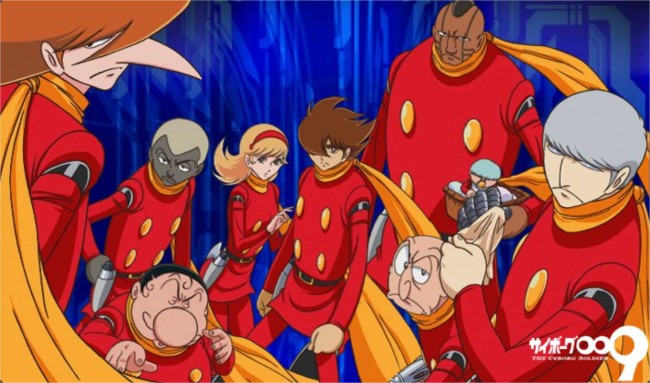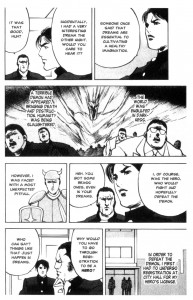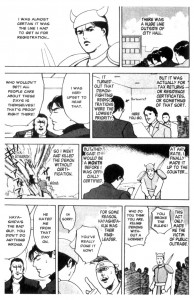
and we are all cyborgs
March 19th, 2014 Posted by david brothersLast year, I provided an afterword for Archaia’s release and updating of Shotaro Ishinomori’s Cyborg 009, drawn by Marcus To, written by FJ DeSanto, and colored by Ian Herring. My copyright was left out of the book, but part of the deal was I kept the rights to the text so I could bring it here and show it to you. If you’re into Ishinomori, this Cyborg 009
dvd set is well worth checking out, too. This text is as it appeared in the hardcover, though I’ve styled the titles and headers differently than they appeared in print.
Something as simple as a cursory overview of Shotaro Ishinomori’s career can impress even the most jaded comics fan. He holds the Guinness World Record for “Most Comics Published By One Author,” laid the foundation for two separate popular genres, and blazed several different trails across a wide variety of projects. He had a fuller career than most people dream of, and even fifteen years after his death, his creations are still being revamped, remastered, and revived for all-new audiences. His influence is tough to overstate, and his remarkably fruitful career has resulted in a bibliography that’s a library unto itself.
Ishinomori often worked in a science fiction mode, filling his stories with giant monsters, transforming heroes, and robots big and small. His bombastic sci-fi tales worked magic on his target audience — young children and teens, generally — but that doesn’t mean that they didn’t appeal to adults. The contrary is true, in fact. Ishinomori employed classic hero versus villain tropes and slapstick humor in his work, but made sure to include just enough nuance and depth to make the stories fascinating from an adult point of view, as well. The subtext in his work speaks volumes, and often presents a fascinating point of view. Beyond that, the subtext meshes with the child-friendly material in a remarkably organic way.
Cyborg 009 is a classic example of Ishinomori’s broad appeal. A team of nine humans-turned-cyborgs rebel against Black Ghost, an evil organization bent on doing wrong. They fight other cyborgs and giant robots using special powers and laser guns. Each cyborg has his or her own custom power or specialty. Some are capable of moving at mach speed, while others can breathe flame. The fights are flashy and exactly as exciting as they need to be, but the subtext provides Cyborg 009 with an unexpected amount of depth. That depth makes the conflicts in the series even more resonant and exciting. It hints at a greater context than something that is purely the forces of good battling the forces of evil.
Cyborg 009 begins with a history lesson. Ishinomori quickly summarizes World War II, including the dropping of atomic bombs on Hiroshima and Nagasaki, before introducing the idea of nuclear proliferation and the Cold War. He then immediately transitions to a meeting of the real villains of the series, creating a direct link between war and our villains. Instead of being a shadowy cabal of evil magicians, scientists, or aliens, the men behind the horrors sweeping over the globe were much more mundane. They were mere arms dealers and warmongers. They put up with the dramatic overtures of the Black Ghost and produce weapons of mass destruction in order to make money hand over fist. The evil of their actions is simply an acceptable side effect of business. It’s collateral damage.
Ishinomori’s use of warmongers as the prime movers of the series is pointed casting considering the atmosphere at the time. Cyborg 009 debuted in 1964. That’s less than 20 years after the end of World War II and the introduction of atomic warfare, 11 years after the end of the Korean War, and square in the middle of rapidly escalating violence in Vietnam. The world was in the process of being carved up by opposing forces, and the business of war was booming. The creation of newer and more lethal weapons allowed war to become a very profitable enterprise. The predations of warmongers partially led to the overwhelming paranoia and fear that permeated the Cold War era, and nuclear panic ensured that everyone knew that the world could end at any moment.
It’s telling that the villains have such a banal motivation, as well. Ishinomori’s villains may employ the classically cartoonish and outlandish tactics that you would expect from an organization with a name like “Black Ghost,” but at their core, they’re simply men who want more than they have and will stop at nothing to get it. They’re greedy, and greed is a very human failing. The human element is what makes Ishinomori’s stories so resonant, even decades after they were first introduced. The villains in Cyborg 009 are human to the core, and it is the very human capacity for unthinkingly callous evil that drives the Black Ghost.
The cyborgs are part of an arms race. In this case, the warmongers want to create new weapons to take advantage of new battlefields, and thereby avoid the peace process. They’re an escalation, another result of the evolution of war. Black Ghost’s plan to turn humans into cyborgs requires the corruption of human beings. Rather than soliciting soldiers or building a volunteer army of cyborgs from scratch, the organization chooses to kidnap innocent humans from a variety of places and walks of life and turn them into cyborgs. The Black Ghost, like war, can and will touch you, no matter how far removed you may think you are from the conflict.
The international and diverse cast of Cyborg 009 hammers that home. Our nine cyborg heroes and the cyborg villains they battle are ballerinas and chefs, actors and delinquents, privileged and oppressed, adults and children. They represent us; they represent humanity. The cyborgs are unique, both in power and personality, but they all have a great capacity for good or evil. Like most humans, they simply have to choose between their baser natures and doing good.
The concept of free will is a vital part of the Cyborg 009 story, but Ishinomori explores coercion and the limits of free will, as well. The villainous cyborgs are under the control of evil forces, but still manage to demonstrate genuinely human traits, sometimes even in the midst of battle. Sometimes they’ve been bullied and are lashing out, and other times they repay a kindness as best they can, even if it goes against their programming.
They are human first, even when their human identity has been stripped away. Many of the cyborgs have been altered far past the point where they can be strictly defined as human. Cyborg 0013, for example, is a giant robot, while another is a Western-style mansion. But, no matter what we go through, no matter what horrors, we are still human. We have the capability to not just adapt to our situations, but to overcome them.
Part of what gives us the strength to overcome adversity is our community. We find strength in groups, wisdom from our elders, and motivation from seeing people like us succeeding. In the case of Cyborg 009, Dr. Isaac Gilmore serves as their mentor and engineers their jailbreak. Gilmore served as a scientist in the Black Ghost organization, and shares responsibility for the creation of the cyborgs. He rebelled against his employers, and in doing so, represents another important aspect of the human experience: repentance.
Gilmore, as an agent of the Black Ghost, did wrong. His intentions may have been honorable, but he took part in an experiment that forever ruined the lives of more than a dozen human beings. Many of the advances in science that led to the creation of weapons of mass destruction didn’t come from men and women who wanted to destroy the world. The pursuit of knowledge often comes with a catch, and Gilmore was lucky enough to realize the catch before he progressed too far down a dark path. He chose to stop and repent for his dirty deeds, and that gives him a strength and depth that is vital for the story of Cyborg 009.
Making up for mistakes is an important part of the human experience. It’s a way of exercising control over both yourself and your environment. You refuse to let yourself be defined by your mistakes, you work to make up for those mistakes, and in doing so, you change the world around you. You become the good person that you want to be when you seek forgiveness for your mistakes, and the knowledge that you have the capacity to slip up keeps you on the straight and narrow. You’ve been there before — you don’t want to go back again.
Joe Shimamura, better known as 009, is another example of a heroic character with rough edges. Originally, he was the son of a Japanese woman and a foreign father. He was considered an outcast, and he suffered for his heritage. He was bullied and teased, and he slipped fairly easily into the life of a delinquent. He didn’t become an outlaw because he wanted easy money, or because he felt like being a delinquent was fun. He was forced into a corner and he adapted.
He never left behind his inner goodness, however. After becoming a cyborg and returning to Tokyo, he comes across an old friend in Shinjuku. The friend is more than willing to bully and rob another person, but 009 rejects that idea. He stops his friend and rebukes him in front of a complete stranger. This kindness is repaid later, when the stranger is revealed to be a rival cyborg in disguise and chooses to spare 009’s life.
009’s graciousness is another sign, and an important one. You always have a choice. If you find yourself between a rock and a hard place and you do something wrong, that doesn’t mean that you’re incapable of doing right. It just means that you made a choice. You can always choose differently, even if it means temporarily alienating a friend to comfort a stranger.
The fact that 009 is the titular character and the window into the Cyborg 009 universe is fascinating. We see the world through 009’s eyes, and as a result, we can’t help but identify with him. 009 and the reader are both new to the world Ishinomori has created, and 009’s experiences color our own experiences with the world.
Many heroes are written as if they were always morally upstanding and have never, ever wavered in their beliefs. It’s a comforting idea to think that there is someone out there who always makes the right decision, but that isn’t realistic. Everyone makes bad decisions and goes through trials and tribulations. 009 is no different from anyone else. The difference is that he’s made the decision to reject the negative choices he made before, and to do right from that point on.
Francoise, unit 003, is innocent and unaffiliated. Where 009 had to fight simply for the right to live life as he wanted before he became a cyborg, 003 spent her time as a ballerina. Her passion was to entertain people, to be a living work of art. In a way her purpose in life was the opposite of what war represents. War devastates communities, destroys livelihoods, and lines the pockets of the men and women who don’t care who they hurt. There are no winners when it comes to war.
Dancing, on the other hand, is meant to enrich our lives. You can experience it on a physical level, as you admire the acrobatics and contortions the dancer performs. You can also experience it on an emotional level, as the movements of the dancer spark feelings within you. Dancing is meant to create appreciation in a viewer, while war only ever creates conflict.
By drafting 003 into their war, the Black Ghost organization is doing exactly what war does: it corrupts innocence. It takes something beautiful — whether that’s dancing or simply living your life as you wish — and dashes it against the rocks. It’s cruel and unfair and 003 is a perfect example of why. She’s a kind and sweet person, nice almost to a fault, and she did absolutely nothing to deserve her fate.
War respects no one. It doesn’t pick and choose whom it affects. It simply happens and we’re left to pick up the pieces. In the case of 003, she was left enhanced by her experience with the Black Ghost, thanks to the addition of high tech communications capabilities, but is left divorced from her previous life. She can’t go back, not without bringing the baggage she now carries with her. War’s touch is indelible. You can move past it, but it sticks with you. You’re forever changed.
One of the most impressive things about Ishinomori’s original Cyborg 009 stories is how resonant and relevant they remain to this day. The world has existed in a state of constant warfare for decades now, if not longer. Skimming the newspaper or Internet shows that armed conflict is a fact of life for many, many people. There are powers beyond our control that wish to divide the Earth up, reasonable people who have been forced into bad situations, and bad people who are eager to take advantage of bad situations. War is here, it is real, and sometimes it’s even right outside our window.
Ishinomori’s cyborgs represent us, but they do more than that. They encourage us. They inspire us. They suggest that someone, somewhere can stand against great evil and not just survive, but succeed. They can make a difference, whether that difference is pushing for nuclear disarmament in real life or battling evil cyborgs in fiction. All it takes is making a choice. The specific choices change as time goes on, but the core idea is incredibly versatile.
The cyborgs are human. Once you understand that, the meaning behind the rest of the series flows like water. Their enemies are war incarnate, men and women who would exploit the Earth for their own gain. After being touched by those enemies, the cyborgs are decidedly different than they were before, but their innate human goodness remains the same. They rage against the injustice they suffered, and they fight to make sure that that injustice is never perpetrated again.
The setting of Cyborg 009 is a world that is constantly on the brink of being destroyed. Governments wage war, shadowy figures finance and enhance those wars, and the only thing stopping humankind from being overrun are the actions of honest and moral human beings who refuse to let the wrong side win. The cyborgs are sacrificing their lives to prevent that exact outcome. There are plenty of reasons to be afraid, but there is a reason to have hope, as well.
Seeding a comic intended for children with these ideas may seem strange at first glance, but Ishinomori pursued his allegory in such a way that the story remains perfectly appropriate for all ages. Ishinomori stops well short of becoming overbearing or preachy. There’s nothing in there that’s inappropriate for children. Ishinomori couches the allegory in familiar ideas: a delinquent with a secret heart of gold, a wizened mentor, and a flashy and bombastic evil organization. It’s only once you scratch the surface that you realize the reason why Cyborg 009 works as well as it does is because it is working with deeper themes than pure “good versus evil” or squeaky-clean generic adventures.
– david brothers, 2013














